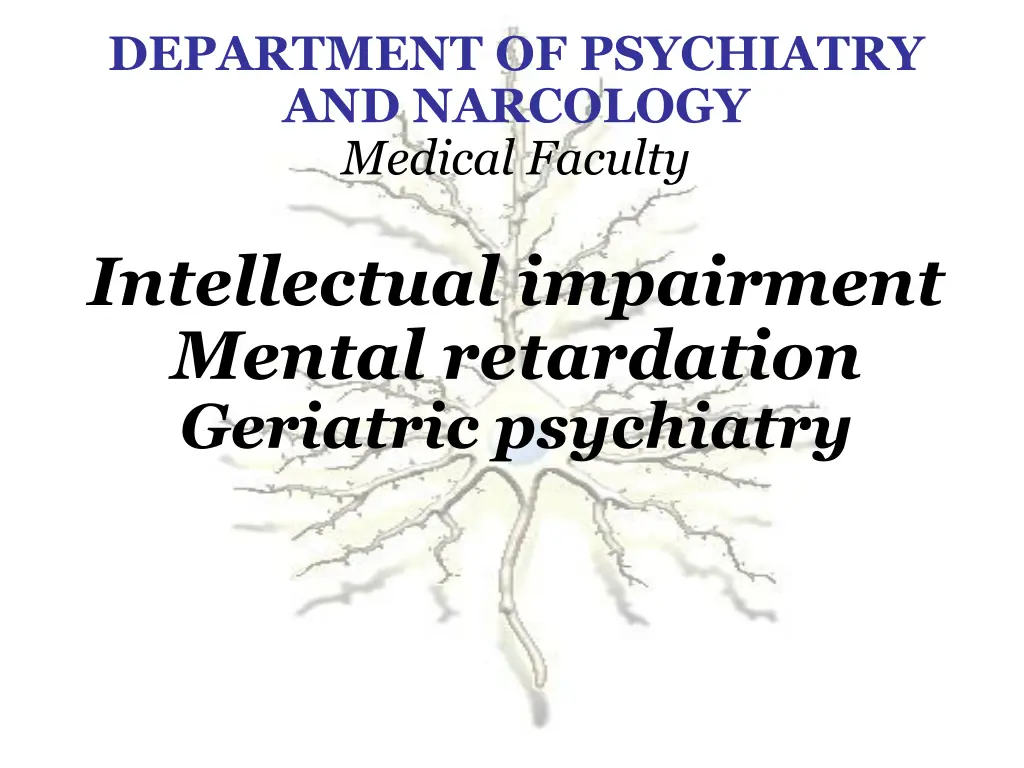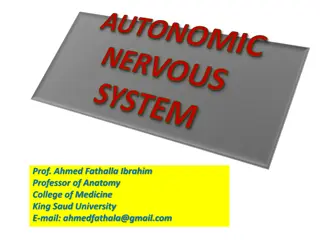
Understanding Mental Retardation: Causes, Symptoms, and Classifications
Explore the pathology, classification, and characteristics of mental retardation, a condition characterized by intellectual disability and lack of progression. Learn about the different levels of severity, etiology, and clinical presentation associated with mental retardation. Discover how mild mental retardation affects learning, speech development, behavior, and memory.
Download Presentation

Please find below an Image/Link to download the presentation.
The content on the website is provided AS IS for your information and personal use only. It may not be sold, licensed, or shared on other websites without obtaining consent from the author. If you encounter any issues during the download, it is possible that the publisher has removed the file from their server.
You are allowed to download the files provided on this website for personal or commercial use, subject to the condition that they are used lawfully. All files are the property of their respective owners.
The content on the website is provided AS IS for your information and personal use only. It may not be sold, licensed, or shared on other websites without obtaining consent from the author.
E N D
Presentation Transcript
DEPARTMENT OF PSYCHIATRY AND NARCOLOGY Medical Faculty Intellectual impairment Mental retardation Geriatric psychiatry
INTELLIGENCE Intelligence includes acquired knowledge, experience and the ability to further accumulate and use it in mental activity. The intellectual qualities of a person are determined by the range of his interests and the amount of knowledge. Thinking is intelligence in action.
PATHOLOGY OF INTELLIGENCE PATHOLOGY OF INTELLIGENCE congenital mental retardation (oligophrenia) acquired decline in intelligence (dementia) imbecility imbecility idiocy lacunar (partial) diffuse (total)
PATHOLOGY INTELLIGENCE Mental retardation is a congenital or early acquired (in the first 3 years of life) dementia, expressed in underdevelopment of the entire psyche, but mainly the intellect. Dementia acquired dementia with the collapse of mental activity
Mental retardation A clinically homogeneous group of diseases of various etiologies associated with disorders of ontogenesis, united characteristics: by two obligatory Mental underdevelopment with a 1. predominance of intellectual disability 2. Lack of progression
Mental retardation 3 5% of the population suffers from mental retardation 75% of them have mild mental retardation In 50 90% of cases, the etiology is unknown: undifferentiated UO differentiated control system
CLASSIFICATION of mental retardation According to the severity of dementia Etiological classification By temperament According to the complexity of the clinical picture
Mild mental retardation (moronic) Capable of learning Master simple work processes Speech development Behavior is appropriate and independent Good mechanical memory, imitation Weakness of abstract thinking, concreteness of associations It is difficult to move from simple generalizations to more complex ones Lack of initiative, inertia Weakness of self-control, inability to suppress urges Impulsivity of behavior, increased suggestibility Adapted to life
Moderate degree of mental retardation ( imbecility) Learning disabled Disabled Only basic acts of self-service are available Speech is tongue-tied and agrammatic, vocabulary is 200 300 words Learn neatness skills and eat independently Mechanical memory, imitation Sometimes they master ordinal counting and know individual letters Simple generalizations They find their way around in everyday life, but get lost in unusual conditions. Extreme lack of independence, poor switchability Emotions are poor and monotonous All mental processes are slow and inert Need constant supervision and care
Severe and profound mental retardation (idiocy) There is no reaction to usual stimuli or it is inadequate Attention is absent or extremely unstable Speech is not developed, individual sounds, words They do not understand the speech addressed to them Do not master static and locomotor skills Meaningful activity is not available They do not have simple self-care skills and are untidy Fixed or stereotypical monotonous, meaningless movements They don t differentiate between relatives and strangers Elementary, primitive emotions in the form of excitement or screaming An affect of anger and aggressive tendencies, often directed at oneself, easily arise Profound defects in physical development
PATHOLOGY OF INTELLIGENCE DEMENTIA Acquired dementia resulting from a weakening of the intellect: Total (globular, diffuse) Lacunar (focal)
PATHOLOGY OF INTELLIGENCE TOTAL DEMENTIA: Gross impairment of intellectual abilities Personality breakdown Severely impaired memory Can't use past experience There is no criticism of my condition
PATHOLOGY OF INTELLIGENCE LACUNAR DEMENTIA Intelligence is partially impaired Thought processes slow down Moderate memory loss A critical attitude towards one s condition is maintained
Geriatric psychiatry ( gerontopsychiatry ) study of psychiatric pathology that occurs during the period of reverse development of the body, as well as the influence of aging processes on the manifestations of mental illnesses that began earlier.
MENTAL DISEASES OF LATE AGE According to the timing of manifestation of mental illnesses in psychiatry, there are: Involutionary age 45 - 60 years Old age over 60 years
MENTAL DISEASES OF LATE AGE MENTAL DISEASES OF LATE AGE Involutional or presenile, psychoses (involutional melancholia, presenile paranoid) Senile, senile psychoses (senile dementia, Alzheimer's disease) and systemic atrophic diseases of the brain (Pick's disease, etc.) Mental disorders associated with menopause
INVOLUTIONAL PSYCHOSES A group of mental illnesses that manifest in the involutionary period and in old age, which do not lead to dementia, i.e. are functional. Involutionary depression Involutionary paranoid
INVOLUTIONAL PSYCHOSES The role of the following factors is more significant than in middle-aged psychoses: Premorbid personality type (rigidity, anxious suspiciousness traits, etc.) Situational and traumatic factors Mild, but reducing the body s resistance, somatic diseases, etc.
INVOLUTIONARY DEPRESSION (MELANCHOLIA) Most often it occurs in women aged 50 - 60 years. The leading syndrome throughout is involutional melancholia - anxious and melancholy depression with frequent addition of delusional ideas of self- blame, humiliation or hypochondriacal nature .
INVOLUTIONARY DEPRESSION Simple depression : development and content are closely related to situational and reactive moments anxious coloring of depressed mood hypochondriacal fears. Exodus: favorable sometimes transition to persistent subdepressive states with gloominess hypochondriacity and increased
INVOLUTIONARY DELUSIONAL PSYCHOSES Hallucinatory-paranoid psychoses of late age with a clear tendency to syndromic complication, particular to the development of mental automatism. in involutionary paranoia involutional paraphrenia presenile delirium of damage
INVOLUTIONARY DELUSIONAL PSYCHOSES: The disease is characterized by the gradual development of persistent delirium against the background of clear consciousness and outwardly ordered behavior. Typical structure of delirium and its plot. The delusional concept involves a narrow circle of people (neighbors, acquaintances) who are suspected of deliberately causing all sorts of trouble. The theme of delusional constructions usually does not extend beyond narrow everyday relationships ( delusions of smallscope , ordinaryrelationships ).
Cases of senile dementia can be divided into three groups according to etiology and pathology: 1. Dementia of the Alzheimer's type , in which the same pathological changes occur in the brain as in dementia of the Alzheimer's type with onset in the presenile period. This is the most common type of senile dementia. 2. Multi-infarct dementia . Caused by multiple infarctions in the brain caused by blockage of blood vessels. This group corresponds to the older diagnostic category of arteriosclerotic dementia. 3. Dementia due to other causes . This group includes cases of dementia due to a variety of causes, such as neoplasms, infections, toxins and metabolic disorders, some of which are reversible (Larson et al. 1984; Marsden 1984).
CEREBRAL ATROPHIC DISEASES UNITE Subtle initial symptoms Slow gradual but chronically progressive irreversible development Dementia progresses Neurological symptoms appear at different stages
All dementias are equifinal Agnosia Apraxia Amnesia Agraphia Acalculia Aphasia Apathy Asthenia All types of disorientation...
CLASSIFICATION OF ATROPHIC PROCESSES: 1 . presenile dementia: a) systemic atrophy peak disease, Huntington's chorea , Parkinson's disease, Creutzfeldt -Jakob disease , etc. b) Alzheimer's disease 2. Senile dementia
ALZHEIMER'S DISEASE An atrophic disease of the brain that manifests mainly in pre-senile age (between 55 and 65 years and even at 45-50 years) , which leads to total dementia and is accompanied by focal disorders and disorders of higher cortical functions. The course of the disease is protracted (up to 10- 15 years). It is pathognomonic that at the beginning it is not personality changes that come to the fore .
ALZHEIMER'S DISEASE A debilitating process that is joined by: breakdown of speech, praxis, counting and recognition progressive amnesia, confabulations amnestic disorientation Disorders of attention, perception, and understanding of the environment begin early and progress
ALZHEIMER'S DISEASE Psychotic disorders in 30-40% of cases : Vestigial delusional, paranoid and hallucinatory syndromes Poorly systematized delusional ideas of harm, jealousy, persecution on a small scale The outcome is a complete collapse of mental activity, complete helplessness and total aphasia
PEAK DISEASE A debilitating organic process accompanied by various focal disorders Refers to systemic atrophies, i.e. to the group of endogenous degenerative-atrophic processes with different localization in the nervous system. The disease is based on progressive atrophy of individual areas of the brain, usually the frontal and temporo-parietal lobes.
PEAK DISEASE Personality changes It becomes impossible to adequately assess the surrounding situation, the criteria for generally accepted rules of behavior are lost, and the sense of proportion and tact disappears. The patient begins to commit ridiculous acts, blunders and professional activities without noticing it.
PEAK DISEASE Focal cortical disorders are required: Speech decay, total aphasia Amnestic aphasia Echolalia Disturbances in reading, writing, arithmetic, apractical symptoms are moderately expressed Extrapyramidal disorders
PEAK DISEASE EXODUS Global dementia Total collapse of speech and activity and recognition Marasmus Complete helplessness The prognosis is unfavorable
HUNTINGTON'S CHOREA One of the forms of brain atrophy that manifests itself in middle or old age is manifested by: hyperkinesis type chorea psychopathic psychotic disorders a kind of dementia DEMENTIA does not correlate with the severity of hyperkinesis accompanied by increased affective and psychopathological changes has low progression and shallow depth memory and reproductive memory disorders defects in conceptual thinking extreme instability of attention
PARKINSON'S DISEASE Shaking paralysis is a degenerative- atrophic disease of the brain that manifests itself at a late age, manifested mainly by extrapyramidal disorders, but often occurring with mental disorders
PARKINSON'S DISEASE depressive disorders delusions of harm and persecution on a small scale persistent mnestic-intellectual defect combined with mild euphoria often psychotic episodes: states of confusion with excitement, delirious phenomena, hallucinatory disorders
SENILE DEMENTIA Includes various types of senile dementia and senile or senile psychoses; this is the most characteristic mental illness involution with progressive decay of mental activity, ending in most cases with total dementia of senile
SENILE DEMENTIA A gradual increase in personality changes in the form of a sharpening of previous character traits Narrowing of interests, loss of affective responsiveness Signs of personality regression Progressive amnesia, confabulations Changes in affect from gloomy depression to carelessness, complacency Distortion of the rhythm of sleep and wakefulness Verbigeration, echolalia Depression or mania, delusions of damage
THANK YOU BEHIND ATTENTION






















